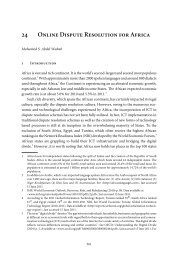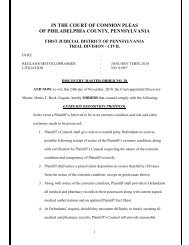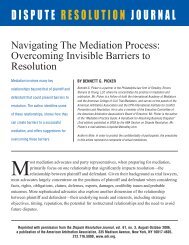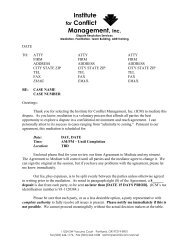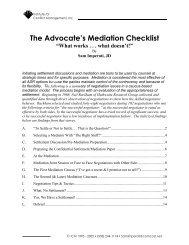17 e-Mediation - Mediate.com
17 e-Mediation - Mediate.com
17 e-Mediation - Mediate.com
Create successful ePaper yourself
Turn your PDF publications into a flip-book with our unique Google optimized e-Paper software.
<strong>17</strong> e-<strong>Mediation</strong><br />
4.2 Process Issues<br />
4.2.1 Process Stages<br />
Beyond the general worldview/approach discussion above, not all stages of any particular<br />
process-model a mediator is employing are substantially affected by the online medium.<br />
Reviewing the process, it would seem that the stages most affected are the early steps of<br />
the process, which we will discuss briefly in this section.<br />
4.2.2 Preparation<br />
The pre-process preparation phase requires more intentionality and investment than faceto-face<br />
interventions. In addition to any substantive preparation mediators might routinely<br />
conduct for any given mediation, there are particular medium-related preparatory actions<br />
e-mediators should not neglect. Mediators would do well to use this stage to build rapport<br />
with parties, which will translate into in-process trust. 55 They need to find ways to personalize<br />
themselves to the parties, eliminating distance and creating social presence – such as<br />
through means of introduction, sending a picture or a wel<strong>com</strong>ing video, making an initial<br />
phone call to lend voice to the interaction, etc. They need to evaluate parties <strong>com</strong>fort and<br />
experience in the online environment, and the degree to which they are adept with the<br />
particular platform or <strong>com</strong>munication method to be used in the actual process. This might<br />
include conducting a test run to make sure that everything functions well and that parties<br />
know which icons to click on. They need to prepare (and perhaps try out) a backup method<br />
for <strong>com</strong>munication in the event that the primary channel fails for whatever reason. 56<br />
4.2.3 Agreement to <strong>Mediate</strong><br />
The usual language of a mediator’s typical agreement to mediate must be adapted to<br />
incorporate issues pertaining to the online environment, which might include costs for<br />
video- or tele-conferencing, methods of accepted and binding signature of documents,<br />
etc. 57 In addition, keep in mind that in face-to-face mediation, signing the agreement to<br />
mediate is often preceded by an explanation of its content in simple language. In text-based<br />
e-mediation, it might seem redundant to write what is essentially the same thing twice.<br />
Mediators must find a way to verify that the agreement is understood and accepted. This<br />
might be a good reason for using simple-to-understand language in the agreement itself,<br />
or for sending the agreement to parties well in advance, with enough time to ask any<br />
questions they have before the process is due to begin.<br />
55 Morris et al. (2001).<br />
56 For more on preparing for e-mediation, see S. Jani & C. Getz, Mediating from a Distance: Suggested Practice<br />
Guidelines for Family, Victoria, BC, British Columbia Mediator Roster Society 2010.<br />
57 Id.<br />
387



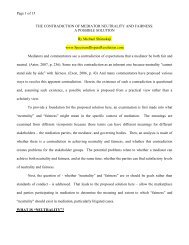

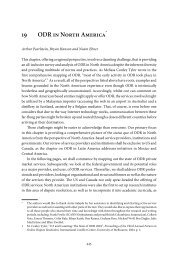
![Settlement Agreement Form [Agreement] - Mediate.com](https://img.yumpu.com/50682143/1/190x245/settlement-agreement-form-agreement-mediatecom.jpg?quality=85)

